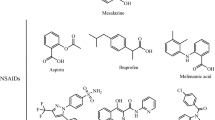Abstract
Using a novel spectrophotometric assay to detect free radical scavengers, the effects of sulfasalazine, a compound frequently administered in the treatment of chronic inflammatory bowel disease, and its main metabolites, 5-aminosalicylic acid (5-ASA), sulfapyridine, and N-acetyl-5-ASA, were compared with biological antioxidants (nordihydroguaiaretic, acid (NDGA), α-tocopherol, and ascorbic acid) and antiinflammatory salicylates (acetylsalicylic acid and sodium salicylate). The results show that 5-ASA, but neither sulfasalazine and its other metabolites, nor the salicylates, shares with the biological antioxidants the property of being a potent scavenger of free radicals. Since 5-ASA is formed in millimolar concentrations in the colon of sulfasalazine-treated patients this mode of action may explain the beneficial effect of sulfasalazine in inflammatory bowel disease. Locally formed 5-ASA may break the free radical chain reaction initiated and maintained by activated phagocytes, thus arresting the perpetuating tissue destruction. This mechanism may indicate a general potential for radical scavengers in chronic inflammation.
Similar content being viewed by others
References
I. Fridovich,The biology of oxygen radicals. Science201, 875–880 (1978).
J. M. McCord,Free radicals and inflammation: Protection of synovial fluid by superoxide dismutase. Science185, 529–531 (1974).
D. Harman,Free radical theory of aging: Nutritional implications. Age1, 143–150 (1978).
G. Scott,Antioxidants in vitro and in vivo. Chem. Britain21, 648–653 (1985).
G. W. Burton and K. U. Ingold,β-Carotene: An unusual type of lipid antioxidant. Science224, 569–573 (1984).
J. M. McCord and I., Fridovich,Superoxide dismutase. An enzyme function for erythrocuprein (hemocuprein). J. Biol. Chem.224, 6049–6055 (1969).
S. Bondesen, O. H. Nielsen, J. B. Schou, P. H. Jensen, L. B. Lassen, V. Binder, P. A. Krasilnikoff, P. Danø, S. H. Hansen, S. N. Rasmussen and E. F. Hvidberg,Steady-state kinetics of 5-aminosalicylic acid and sulfapyridine during sulfasalazine prophylaxis in ulcerative colitis. Scand. J. Gastroenterol.21, 693–700 (1986).
M. A. Peppercorn,Sulfasalazine. Pharmacology, clinical use, toxicity, and related new drug development. Ann. Intern. Med.3, 377–386 (1984).
G. O. Schenck, M. Cziesla, K. Eppinger, G. Matthias and M. Pape,Isobenzpinakol als Ursache des Spektralen Effekts bei der Photoreduktion des Benzophenons. Tetrahedron Lett.3, 193–198 (1967).
O. H. Nielsen and S. Bondesen,Kinetics of 5-amino-salicylic acid after jenunal instillation in man. Br. J. Clin. Pharmacol.16, 738–740 (1983).
P. Sharon and W. F. Stenson,Enhanced synthesis of leukotrienes by colonic mucosa in inflammatory bowel disease. Gastroenterol.86, 453–460 (1984).
K. Lauritsen, J. Hansen, P. Bytzer, K. Bukhave and J. Rask-Madsen,Effects of sulfasalazine and disodium azadisalicylate on colonic PGE 2 levels determined by equilibrium in vivo dialysis of faeces in patients with ulcerative colitis and healthy controls. Gut.25, 1271–1278 (1984).
C. Deby, I. Pincemail, P. Hans, P. Braquet, Y. Lion, G. Deby-Dupont and R. Goutier,Mechanisms of free radicals production in the AA cascade, and role of anti-lipoperoxidants and free radical scavengers. In:Cerebral ischemia, pp. 249–258 (Eds. A. Bes, P. Braquet, R. Paoletti and B. K. Siesjö). Elsevier Science Publishers B. V., New York 1984.
I. Ahnfelt-Rønne and E. Arrigoni-Martelli,Effects of nonsteroidal antiinflammatory agents on arachidonic acid metabolism. Adv. Inflam. Res.8, 83–112 (1984).
W. Roediger, G. Schapel, M. Lawson, B. Radcliffe and S. Nance,Effects of 5-aminosalicylic acid (5-ASA) and other salicylates on short-chain fat metabolism in the colonic mucosa. Biochem. Pharmacol.35, 221–225 (1986).
G. Carlin, R. Djursäter, G. Smedegård and B. Gerdin,Effect of anti-inflammatory drugs on xanthine oxidase and xanthine oxidase induced depolymerisation of hyaluronic acid. Agents Actions16, 377–384 (1985).
V. W. Stuyvesant and W. B. Jolley,Anti-inflammatory activity of d -α-tocopherol (Vitamin E) and linoleic acid. Nature216, 585–586 (1967).
K. Grankvist, S. Marklund and I. B. Täljedal,Superoxide dismutase is a prophylactic against alloxan diabetes. Nature294, 158–160 (1981).
Author information
Authors and Affiliations
Rights and permissions
About this article
Cite this article
Ahnfelt-Rønne, I., Haagen Nielsen, O. The antiinflammatory moiety of sulfasalazine, 5-aminosalicylic acid, is a radical scavenger. Agents and Actions 21, 191–194 (1987). https://doi.org/10.1007/BF01974941
Received:
Accepted:
Issue Date:
DOI: https://doi.org/10.1007/BF01974941




